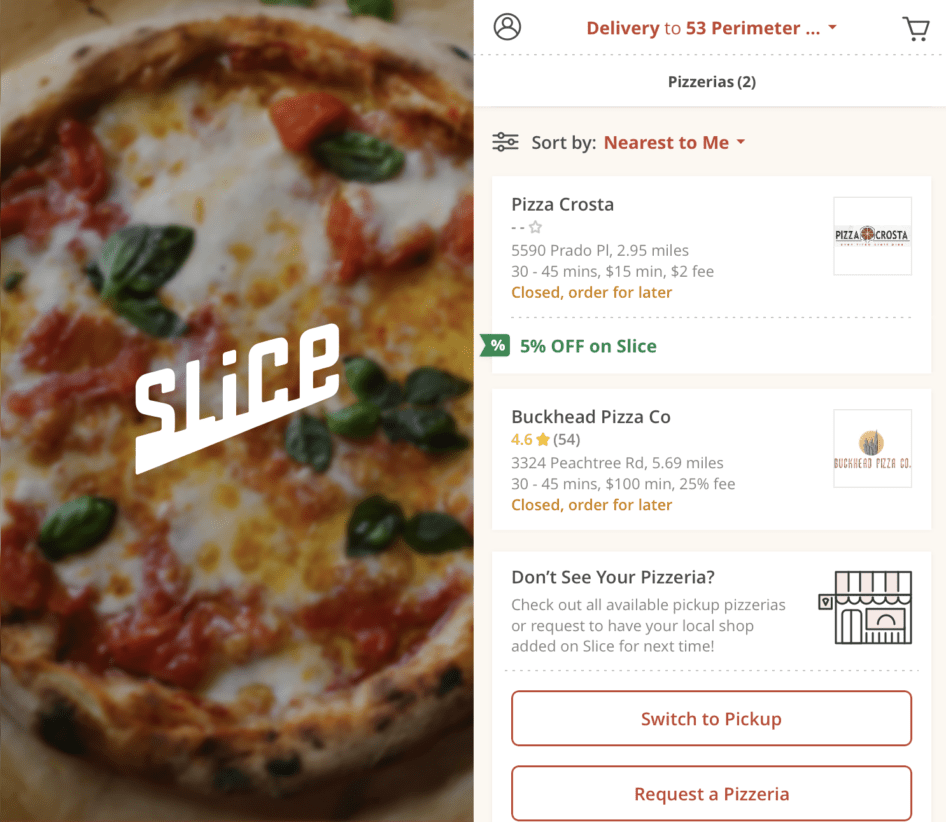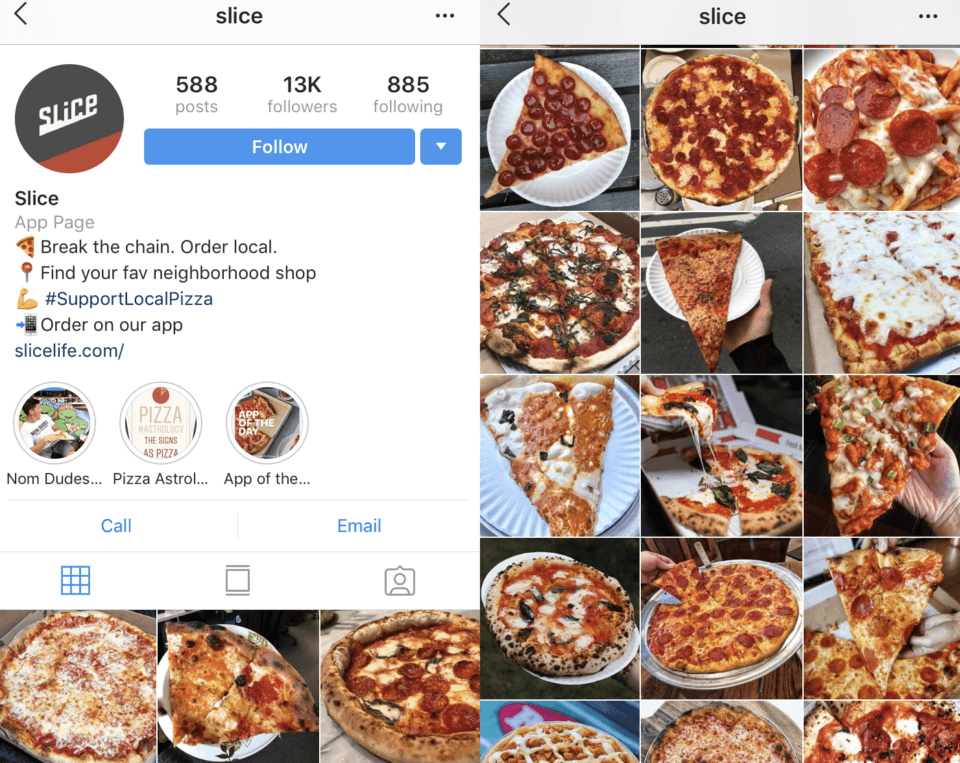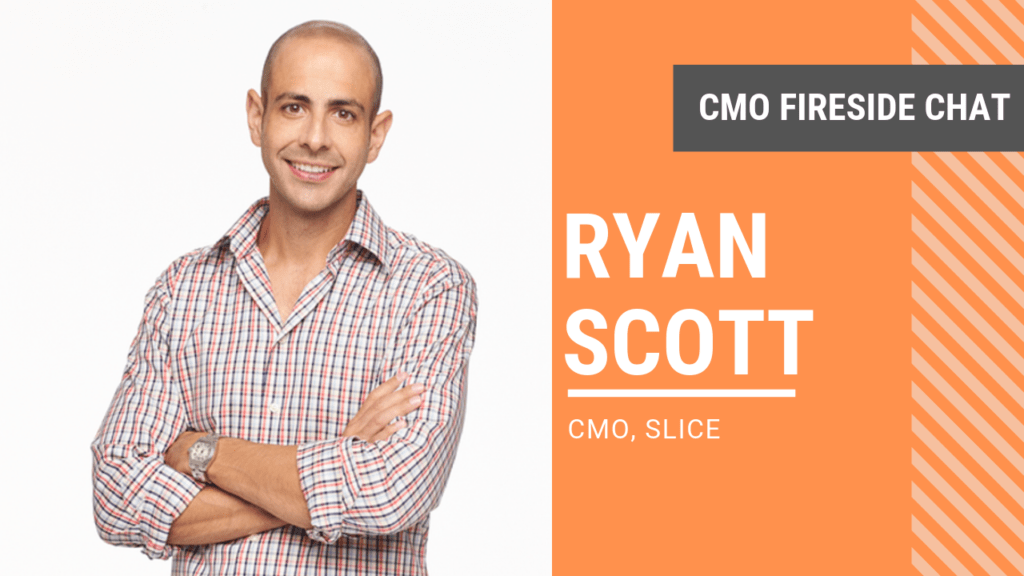Modern technology has disrupted every industry in today’s business environment, including the food delivery space. The wealth of online food delivery services makes it increasingly convenient for consumers in today’s hyper-connected world. However, the majority of independent businesses aren’t built to respond to the rapidly changing environment.
That’s why New York City-based Slice, an independent pizza-ordering platform, was created to help local pizzerias compete in the digital world. The online and mobile ordering platform connects people with authentic local pizza shops. According to Slice, when it comes to getting your hands on quality, authentic pizza at a convenience, you shouldn’t have to make a sacrifice by going to a quick and easy pizza chain. With Slice, “you can have your pie and eat it too.”
Slice empowers local pizzerias with tech, data, and marketing to grow their business, help them compete with big chains, fight back against expensive online ordering platforms that harm small shops, and ultimately take charge of their industry.
Not only do mom-and-pop pizzerias have to combat the challenges of losing profit from using major food delivery services like GrubHub and UberEats, but they also face the competition of massive pizza chains like Domino’s and Pizza Hut that have sophisticated ordering systems. But thanks to Slice, pizza delivery is now more profitable for local pizzerias nationwide.
As a digital executive search firm, we continuously look toward the future of trends in marketing. Innovative tech startups like Slice are similarly on the frontier of digital transformation. We got to discuss how this startup is leveraging technology to help local pizza businesses across the U.S. drive profit with Slice’s Chief Marketing Officer, Ryan Scott.
Slicing Off a Piece of Digital Transformation: How Slice App Supports Local Pizzerias
 Source: Slice
Source: Slice
MarketPro: How did Slice get its start and how has it evolved to what it is today?
Ryan: Slice began as a pizzeria-specific food ordering platform in 2010, originally branded as MyPizza. The founder, Ilir Sela, has a tech background and founded a tech support company called Nerd Force prior to creating Slice. After selling it in 2008, he saw an opportunity in the pizza market because he had 30 cousins who owned pizzerias but noticed that they didn’t have websites. He started to build websites and online ordering functionalities, sourcing his service operations in Macedonia due to a much more scalable cost structure. After a period of rapid growth in 2016, MyPizza became Slice, which hit about 3,000 restaurants and $71.5 million in gross merchant volume. He only had about five people working at the company in the U.S. and a team in Macedonia answering the phones before he ventured out to raise money.
From being the former CMO of Seamless (now merged with GrubHub), I was very familiar with the food delivery service space. Together, Sela and I raised $15.3 million from GGV Capital, a venture capital firm, who led the round.
We then started to move the business model, initiating the “evolution” of Slice. First, we recognized the model had something truly special and ownable. Slice, while it serves consumers, is very merchant-centric, meaning we build the brand presence for these pizzerias. This includes everything from their website to distributing their brand across Google, Bing, Yahoo, Google My Business, and social media. We help businesses create compelling content, drive demand generation, and manage search engine marketing. Our team handles all of their Facebook advertising and retargeting, creates a presence on apps, and executes all of their loyalty generation and marketing.
We essentially become their CRM and operating system. We re-market to the people that don’t return to their shop by sending emails, push and app notifications, and direct mail in some cases. The second piece is servicing and supply. This includes giving pizzerias deals on boxes, cups, and paper menus they send out to market new items and specials.
What we learned is that we have a market network, which is different than a marketplace. A market network is similar to a hub and spoke. The hub is Slice, the platform with all these independent, small businesses where the brand is disproportionally equitable towards the micro brand; in this case, a pizzeria. The spokes are different services such as partnerships with small capital loans, for example. It could be the different supply companies, boxes, cups, menu manufacturers, or any marketing partners that we’re able to leverage to bring these franchise services to independence. The marketing power Domino’s gives to its franchisees is similar to what we give to these local independent pizzerias. 20 percent of Slice’s services encompasses the core ordering capability and 80 percent are all these other value-added services.
MarketPro: Is Slice is the only platform that solely targets pizza?
Ryan: From a brand verticalization standpoint, yes. No one in the world is doing this as far as we know. This is a unique concept, mainly thought of by a founder who lives and breathes pizza. His grandfather, father, and uncles all grew up building out pizzerias and he grew up working in them. He knows where the bodies are buried when it comes to what works, what doesn’t, and what their pain points are. These are all invaluable things he didn’t have to spend time learning because he grew up surrounded by pizzerias.
What’s great about the pizza industry is that there are very repeatable things, such as similar models, pricing, and menu structures. Just imagine many great experiences you can create with a product when you roll up one vertical. For instance, you can get customers to opt into a large pizza deal to drive more orders on a lower volume ordering time of the day, or to stimulate a certain day of the week. Other services that have an aggregator model trying to get pizzerias on board are more consumer-centric. They strive to offer a wide selection of choice for consumers but aren’t powering up the small businesses’ operating systems or from a marketing tech, servicing, or supplies standpoint.
MarketPro: What value does Slice provide independent pizzerias against its competitors?
Ryan: Pizza is a $45 billion market, with 42 percent of it being local independents and 58 percent being the big chains like Domino’s, Pizza Hut, Papa John’s, and Little Caesar’s. However, these independent micro-brands compete in a very great way because they make unbelievably delicious food with heritage and uniqueness. It’s just an authentic way of ordering pizza. These small pizzerias, however, don’t have the martech partner to migrate their business online or get the services that they need to grow their business by hiring. Hiring is challenging when recruiting to get supplies at a lower cost is not their specialty. They’re just one small four wall unit, and don’t have the economies of scale to go and bargain with a Restaurant Depot or a Sysco.
If you look at the food industry right now, we’re in the earliest stages of transformation for restaurants. Many mom-and-pop pizzerias that are sitting in geographies with little choice or selection aren’t being targeted by aggregators because these services don’t think it’s valuable to create a model in a location that lacks options for consumers. Even if they can use major ordering platforms, the price point for restaurants to be on aggregators is costly. The average rates are up to 35 percent (depending if you’re letting them deliver the food).
That’s where Slice comes in. It’s exciting because businesses see around a 30 percent increase in the average check size when they work with us, an increase in new customers, an increase in the frequency of purchases, and get a ton of cost savings from the supply side. We also help them streamline operations by providing a tablet that they can use to help manage their flow of orders in the back of the house. This way, they don’t need to write things down or risk forgetting an order. Slice’s model sees value in these businesses and strives to digitize them. We provide businesses with the platform, brand gen, demand gen, loyalty gen, supplies, and consulting services for just $1.95 on a per order basis.
Ilir has not changed this price since inception. Our business is about economic, service and social empowerment for the SMB community who works mostly seven days a week. They are dealing with rising food costs and rents, and the disruption of change in their communities and businesses around them. That’s why it’s an incredible story. From an ethos standpoint and the way we think about the emotional differentiators of our brand, we want to help local business owners. We want to help the owners deal with the Domino’s coming or a parasitic online ordering company taking up to 35 percent and not having the means, resources and infrastructure to compete.
The app comes with a pizza building feature that makes it easy for customers to customize their order. We have another function where users are anchored to their favorite shops – their “home slice”. Once you’re anchored to a specific pizzeria, your whole communication experience is about that shop – new specials, their story and heritage, and other things that give you a feel for the brand. Every time you come back, you see a picture of their store, your most recent order and you can just reorder right from there. We provide a year-end summary for all existing eaters to show them what they’ve ordered from their home slice, and how they’ve helped that particular owner. Slice is about bringing these authentic, local microbrands to light. It’s giving these guys a chance to get their own piece of the pie, if you will.

Source: Slice
MarketPro: What is the most important component of Slice’s martech stack?
Ryan: It’s our loyalty CRM engine. Take a company like Uber for example. Uber has riders like you and me who all have different riding patterns. We may use it at certain times and we may use other services like Lyft. So if I go out of pattern, Uber may communicate with me to bring me back. In our business, we have these micro brands but we don’t set it up on a Slice level, meaning we don’t look at like how often you come back to Slice. We do it on a per unit level because we’re merchant-centric – the way our offerings are delivered and the communication is coming directly from the store. So, each of these 10,000 stores has their own database and algorithmic churn prevention communication series. With this data, we’ll send out appropriate push notifications and emails.
It’s really powerful because we essentially have 10,000 loyalty engines functioning on different microdata sets. What it does is it generates a loyal customer for these SMBs and draws in revenue. Our martech is built in a very proprietary way. We use some external tools but we build internal algorithms with our data science team to power these loyalty, CRM, and retention engines.
We also take phone orders for pizzerias that don’t want fax, computer, or tablet POS transmission of orders. So, if a user places an order on the app, our team in Macedonia calls the pizzeria and places the order with the shop.
In this space, the uses for AI are vast and we’re currently testing many AI functionalities. We recognized that taking orders during dinner, the peak time, is a challenge for pizzerias. With the help of AI, we can become their advanced order taking center. We could use conversational AI by training it to have the voice of the owner, introducing customers to specials. We could also use AI to learn the patterns of customers and push reorders through texts. Pizza ordering is very behavioral, repeatable and predictable. So, this is an area we are exploring.
MarketPro: What marketing trends do you see in the industry right now that you would want Slice to try in 2019?
Ryan: AI is a big one. We really want to own the phone. 95 percent of food orders were offline in 2015, and today it’s 92 percent. If you break that down for a pizzeria, 70 percent of the orders are on the phone so owning the phone is critical. That’s not really so much marketing as it is using AI to accelerate that product experience. One thing that I’m looking at from a marketing standpoint is packaging. For instance, a “subscribe and save” offer. That type of value creation is huge for consumers and the business; for cohort retention, as we call it in marketing. We can encourage consumers to “subscribe” and get X percent off each time. Rather than calling it a loyalty program, it’s more of a loyalty experience that’s embedded into the product.
We have a functionality coming out with Google Assistant which will be amazing. It will be voice activated ordering for a number of industries and we’re one of their early partners. In fact, we were featured at Google I/O on stage.
Creating a social layer on our supply side is really important. There are brands that have done an incredible job of creating a social layer like Etsy, for instance, which has over 1.9 million sellers. When it first started, it was a movement where sellers on Etsy told other sellers about the platform.
There’s something similar here with pizzerias because it’s a community-driven industry. They all know each other if they’re in the same region because they go to the same two trade shows every year. Taking this social layer and encouraging our pizzerias to interact and connect is important. We started to do a lot more webinars and educational events where we bring speakers to come and share their stories. For instance, we just brought Johnny’s Pizza from North Carolina in and featured the owner, Johnny Pavlik, on a webinar. He’s a great personality, makes great food, has a great story, and is awesome at social. With a team of five people that run social for him, he discussed how his business got over 19,000 Instagram followers. He’s one of our owners and we brought his story to life. So, how do we continue to create that social trusting layer? That that’s a trend I’m seeking and really excited about.
Brand storytelling and evolution are really important. When you have something like what we have –where our brand has an emotional element — you want to capitalize on that. So, bringing more of that story into the product, the app, the mobile experience, and the web experience is something you can expect to see from Slice in the short term. I’m looking at the visual identity of the brand and if we’re leveling the brand up the best we can. The team’s done an amazing job internally, but I think there’s always more there so we’re going to continue to evolve the brand. Some of the things we’re looking at are paid advertising, which is just amplification of a good business.
MarketPro: Does Slice do any traditional marketing?
Ryan: We have an inside revenue team that calls pizzerias and gets them signed on, providing marketing collateral and a demo that shows them the full value of what Slice offers. Once they sign on, they get a welcome kit, something I like to call the Slice Boost Program. It includes instructions and directions on how to use things like box toppers, promotional brand stickers, signage where it has the hours of operation, and coupons to grow their business. We call it four wall marketing. We create napkins, cups, pizza boxes, and menus with branding. All of this helps the local guerrilla marketing tactics and builds a trusted relationship between the pizzeria, customers, and Slice.
We don’t try to do above the line advertising now because we don’t need to. We spend more money on bottom funnel tactics like SEM, strategic marketing distribution partnerships, email marketing, loyalty gen, push notifications, and direct mail to bring customers back. And four wall marketing such as the signage in store, coupons, box toppers, napkins, paper, paper plates, and cups.
MarketPro: Do you plan on leveraging social media more in 2019?
Ryan: Our Instagram presence has gone from 1,000 followers to over 12,000, and is growing at a significant rate. We have territory managers in different markets and a Slice car that’s wrapped with our brand around it. Pizzeria owners come outside, get introduced to the car, take a picture of it, tag their shop, and we tag them in return. We also have a social influencer program where we have college ambassadors set up shop across tons of colleges. We have influencers in the pizza industry who we partner with to get involved with social pizzeria crawls. They run different tag wheels, and implement tactics for content sharing, audience building, and introducing new products.
We also just launched our blog. There’s a huge SEO value there but more importantly, great content. We’re really anchored to showing our authority by sharing the local favorites and hidden gems in your area and teaching people about the craft. The owners get a lot of presence and education too – they love to read up on their craft. Social is going to continue to be a huge investment. We are primarily focused on building a high-quality organic base through great content and good value creation. From a paid social standpoint, we are going to focus on retargeting.

Source: Slice
MarketPro: Digital transformation will grow to become more important for brands across all industries in 2019. How can CMOs who grew up in a more traditional space adapt to a digital world?
Ryan: A lot of CMOs come out of brand and strategy, and go into digital. If you come out of a space like that, you need to hire well. If you’re a really strong brand marketer, that’s great because brands are becoming ever more important to the audiences they serve. Digital is becoming closed and as a CMO, you need to know how to distribute your brand today digitally. If you want to become a scalable solution today, you need to know digital just as well as you know brand. There’s so much technical stuff to know – big data, analytics, best practices, etc. While you don’t need to know it all, you want to thrive on your strengths.
If you’re coming completely from traditional, you need to make sure you hire someone really, really great. Hiring someone who’s a subject matter expert can really compliment your development area because digital isn’t an easy area to learn quickly. You need a right hand that knows digital like the back of their hand to execute internally.
Getting experience is critical. I came out the digital world and didn’t have the brand experience, but now I’ve rebranded three companies and have worked with three of some of the best advertising brand agencies in the world. I learned a lot from that hands-on experience.
Once you have a good understanding, you need to just go into the game and see how you do. There are some big decisions that’ll be made. Unfortunately, there aren’t great boot camps. You can take a master class and there are different things you can do to continue education, but I find that you have to read a ton. Resources like growth hackers blogs are awesome.
Meet with as many digital CMOs as you can. I always tell people coaching and development is great, and we’re always going to coach our people and train our team. I had a CEO who suggested I meet with a bunch of CMOs in his network. We created a CMO forum that got me introduced to a bunch of things that I haven’t done and I got to share things they hadn’t done before. We shared channel best practices, agency best practices, insource versus outsource, how to hire, and who to hire. Embracing, learning and surrounding yourself with people that are peers, and going in with a learning mindset are key.
It is also important that you think about your org design because digital transformation means a lot. There’s a lot of direct response marketing using digital. There is content marketing, storytelling, and creative development using digital. There’s an appreciation for the product – how do you integrate things we’re doing in marketing with the product and vice versa? This is what I call product marketing. Bringing those things to life along with the onboarding experience and loyalty program at the onset of registering for a company where you can already see that points are loaded in right from the get-go. Those are all growth marketing and product marketing tactics. Once you understand the core strategy, you can design the organization to enact it. But if you don’t have the experience, a lot of that’s going to come from hiring really strong people to run those roles.
Ryan Scott on Empowering Local Businesses with Digital Transformation
MarketPro: How important is it for businesses to create the right org structure with the right roles and the right people to fill them?
Ryan: One of the best practices I learned came from an old boss who was a Boston Consulting Group alum and worked in their org design practice. He taught me that you never design an organization until you know the strategy for the company and every single leader at the top level — Director and above — is aligned on what that strategy is. Otherwise, you have imbalances which create cultural tension even if they’re not seen from the outside. Many companies lose sight of this. I had the fortune of being a Co-CEO, so I actually got to see it in motion – scaling over a thousand-person organization.
Take a step back to determine what the strategy is, make sure everyone understands it, what the implications are, and then design your organization to enact it. Start with why you need each role and how it connects to the strategy (which should be informed by one specific metric that moves the needle). Then, determine what the bullet points underneath the roles are. You really optimize organizational design quickly that way. Otherwise, you’re doing it with a gut feeling, which is usually a waste. Doing so may feel right and seem right when you explain it, but when looking at your operational productivity and execution, it’s not going to be as effective. That was one of the best lessons I have learned in my career so far.
Conclusion
Thanks to Slice, local independent pizzerias can now compete with the likes of massive chains while giving them a more affordable alternative to the mainstream online delivery apps available.
Any digital executive search firm knows how digital transformation is changing the face of business. From startups to Fortune 500 companies, the role technology plays in marketing for every organization is incredibly impressive and one that can’t be ignored.
Is your organization embracing digital transformation? How are you evolving to leverage the opportunities modern technology provides? Let us know!




